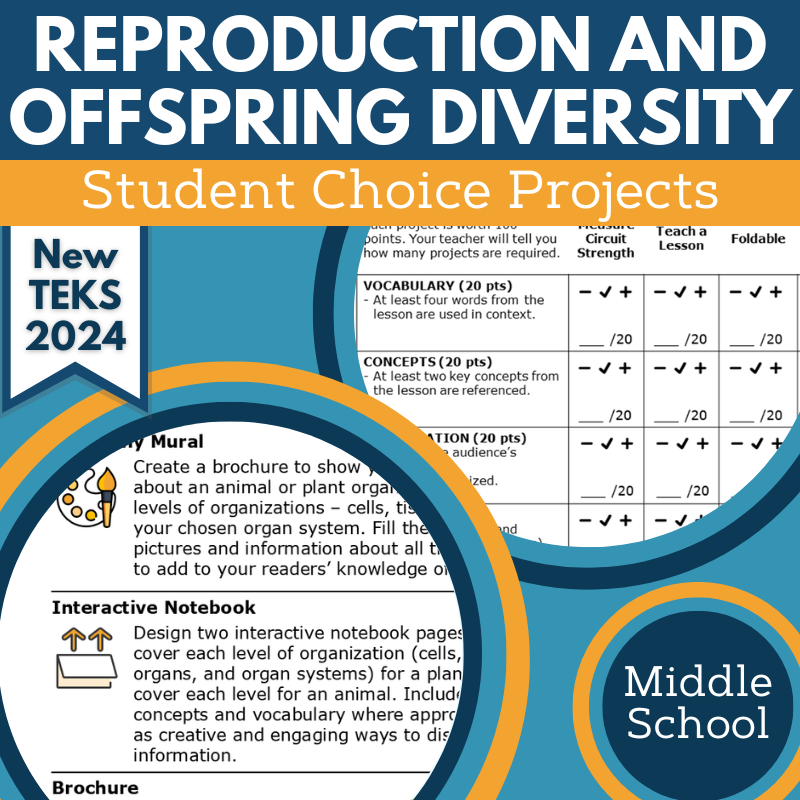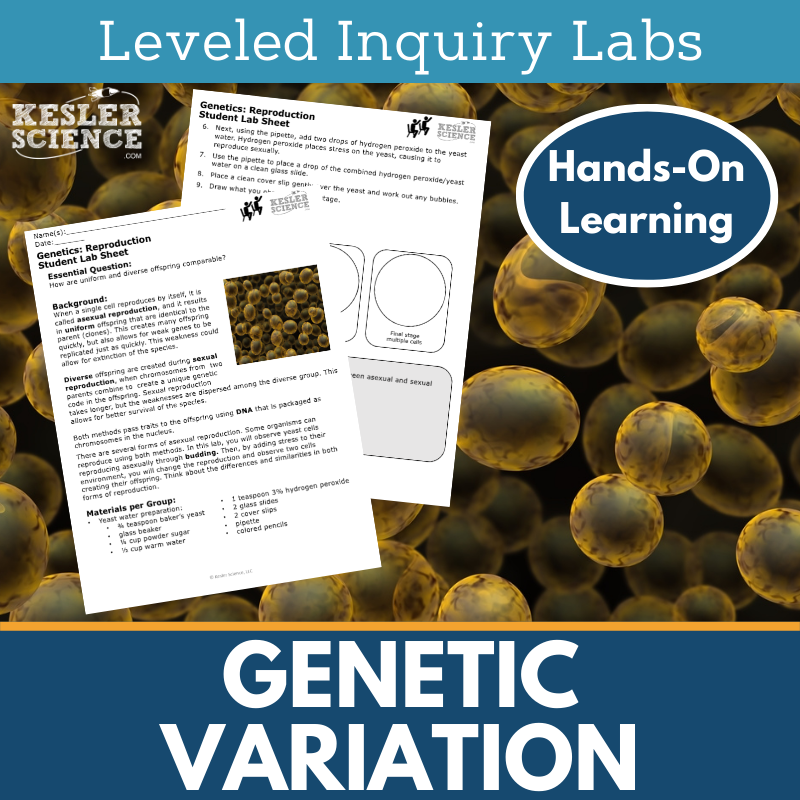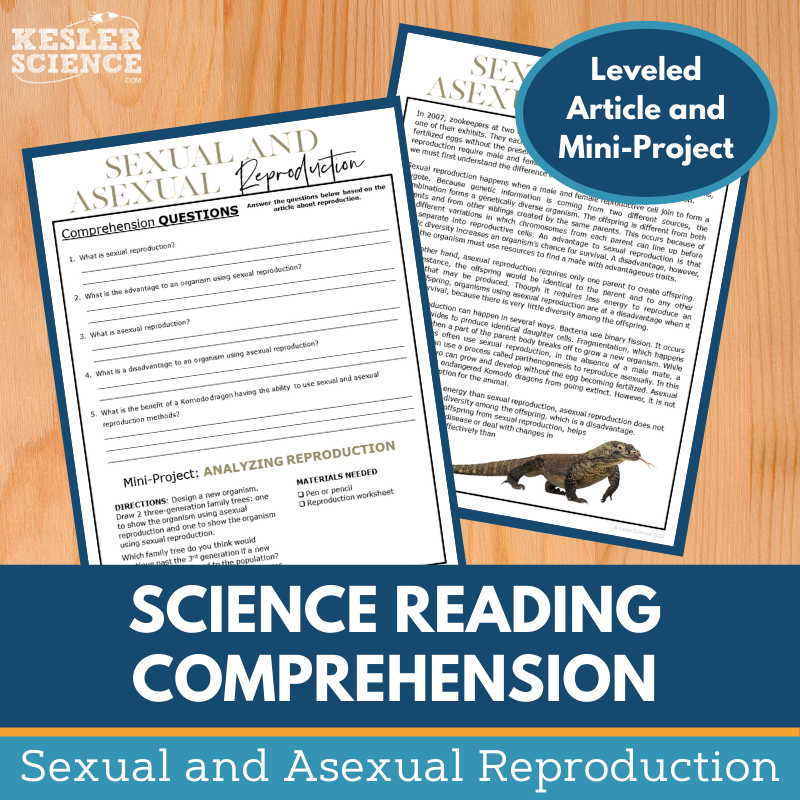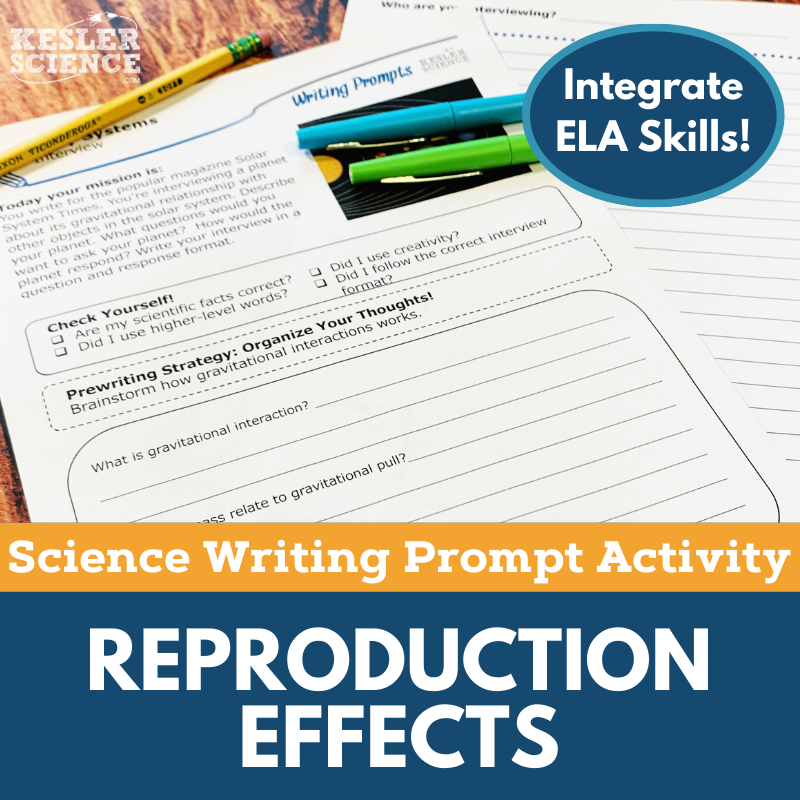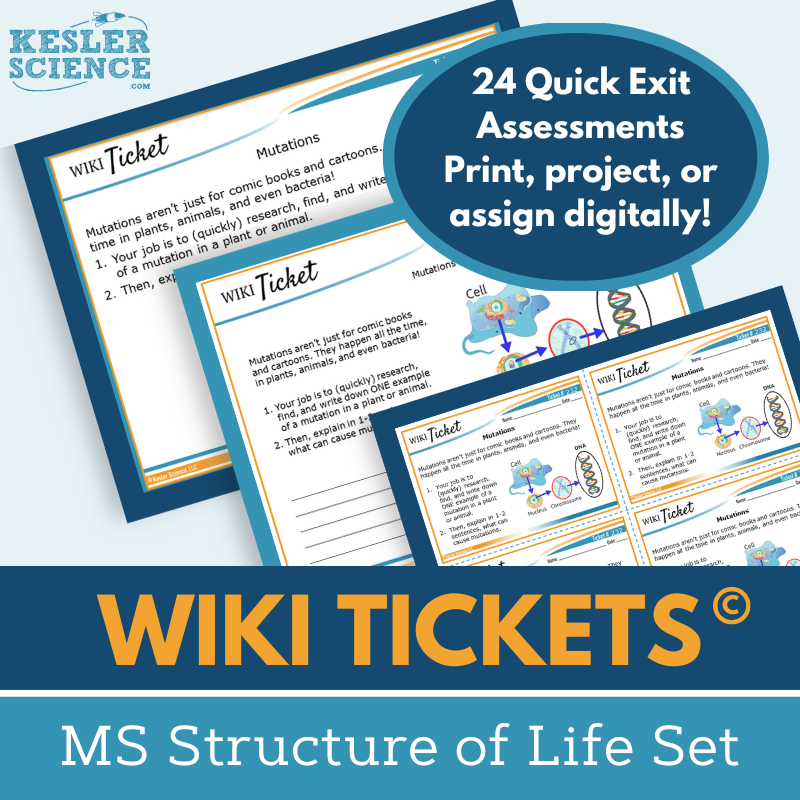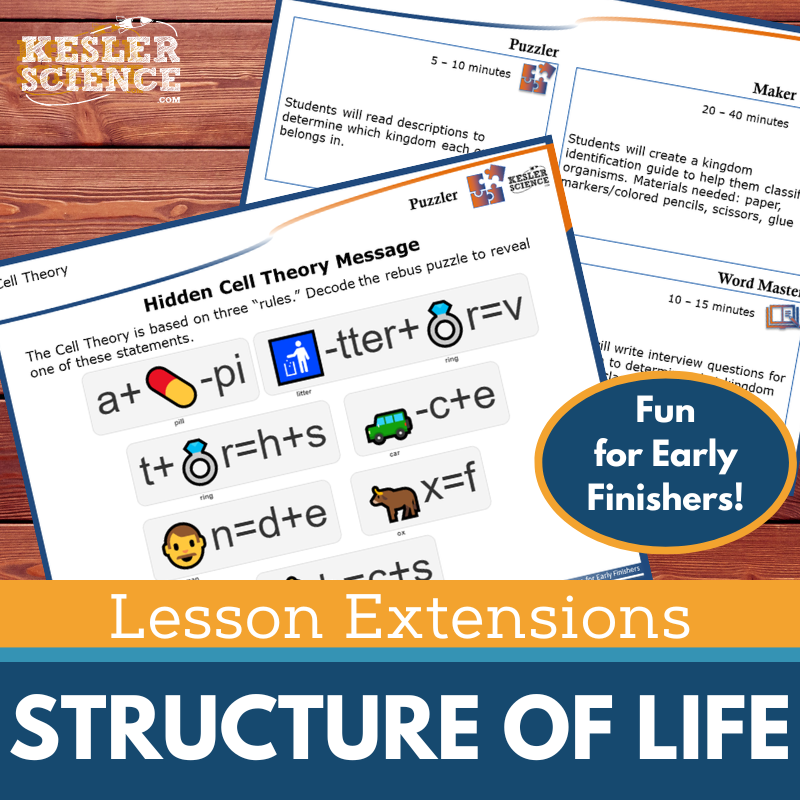Reproduction & Offspring Diversity Activities for Middle School Science
This middle school life science unit covers asexual and sexual reproduction in plants and animals, focusing on their effects on offspring diversity and population changes. The resources below will give students a comprehensive understanding of reproduction and offspring diversity. All of the following materials are also included in the Kesler Science Membership.
This middle school life science unit explores asexual and sexual reproduction in plants and animals, focusing on how these processes impact offspring diversity and population changes over time. The lesson includes editable PowerPoints, worksheets, assessments, and student-choice projects for differentiated, student-led learning. It’s aligned with the 2021 TEKS 7.13C standard and designed for minimal prep.
Students will investigate essential questions such as the differences between asexual and sexual reproduction and their effects on biodiversity. The lesson uses the 5E Model: Engagement, Exploration, Explanation, Elaboration, and Evaluation. The exploration includes differentiated station labs, with nine stations for students to explore concepts through reading, experiments, research, videos, and hands-on activities. Output stations allow students to demonstrate their understanding through categorization, writing, drawing, and assessments.
Interactive and editable materials include PowerPoints, interactive notebooks, and note-taking templates, all available in English and Spanish. Students can extend their learning with choice projects, and assessments are aligned with STAAR 2.0. This comprehensive unit can be used in-person or virtually, offering maximum flexibility for various learning environments.
This middle school life science unit explores asexual and sexual reproduction in plants and animals, focusing on how these processes impact offspring diversity and population changes over time. The lesson includes editable PowerPoints, worksheets, assessments, and student-choice projects for differentiated, student-led learning. It’s aligned with the 2021 TEKS 7.13C standard and designed for minimal prep.
Students will investigate essential questions such as the differences between asexual and sexual reproduction and their effects on biodiversity. The lesson uses the 5E Model: Engagement, Exploration, Explanation, Elaboration, and Evaluation. The exploration includes differentiated station labs, with nine stations for students to explore concepts through reading, experiments, research, videos, and hands-on activities. Output stations allow students to demonstrate their understanding through categorization, writing, drawing, and assessments.
Interactive and editable materials include PowerPoints, interactive notebooks, and note-taking templates, all available in English and Spanish. Students can extend their learning with choice projects, and assessments are aligned with STAAR 2.0. This comprehensive unit can be used in-person or virtually, offering maximum flexibility for various learning environments.
This student-led activity aligns with TEKS 7.13C and focuses on reproduction and offspring diversity. Students explore the differences between asexual and sexual reproduction in plants and animals, investigating how these processes affect offspring diversity and population changes over time. It’s perfect for both in-class and virtual learning environments.
The station lab includes nine modular, differentiated activities, allowing students to guide their learning. Stations include activities like watching videos, reading passages, conducting research, and applying concepts through hands-on tasks. Materials are provided for students to work independently or in small groups, with some stations requiring basic lab materials.
The stations are divided into input and output activities. Input stations introduce concepts with multimodal resources such as videos, readings, and research materials. Output stations give students opportunities to organize, illustrate, write, and assess their understanding. A bonus challenge station offers additional activities for early finishers and advanced students.
This student-led activity aligns with TEKS 7.13C and focuses on reproduction and offspring diversity. Students explore the differences between asexual and sexual reproduction in plants and animals, investigating how these processes affect offspring diversity and population changes over time. It’s perfect for both in-class and virtual learning environments.
The station lab includes nine modular, differentiated activities, allowing students to guide their learning. Stations include activities like watching videos, reading passages, conducting research, and applying concepts through hands-on tasks. Materials are provided for students to work independently or in small groups, with some stations requiring basic lab materials.
The stations are divided into input and output activities. Input stations introduce concepts with multimodal resources such as videos, readings, and research materials. Output stations give students opportunities to organize, illustrate, write, and assess their understanding. A bonus challenge station offers additional activities for early finishers and advanced students.
The Reproduction & Offspring Diversity Student Choice Projects align with the 2021 TEKS standard 7.13C, offering middle school students a selection of project options to showcase their understanding. The project page includes six student-led choices and a “design your own” option, with an editable rubric for assessments by teachers, peers, or students themselves. These flexible, multimodal projects allow students to demonstrate their learning in creative ways, with differentiation options available for both remediation and challenge levels. Teachers can modify the rubric to fit their grading needs.
The projects use common classroom supplies like paper, markers, and scissors, and many can be completed digitally. The resource also includes teacher directions and rubric pages that assess vocabulary, concepts, presentation, clarity, and accuracy.
The Reproduction & Offspring Diversity Student Choice Projects align with the 2021 TEKS standard 7.13C, offering middle school students a selection of project options to showcase their understanding. The project page includes six student-led choices and a “design your own” option, with an editable rubric for assessments by teachers, peers, or students themselves. These flexible, multimodal projects allow students to demonstrate their learning in creative ways, with differentiation options available for both remediation and challenge levels. Teachers can modify the rubric to fit their grading needs.
The projects use common classroom supplies like paper, markers, and scissors, and many can be completed digitally. The resource also includes teacher directions and rubric pages that assess vocabulary, concepts, presentation, clarity, and accuracy.
In this lab, students will observe yeast undergoing asexual and sexual reproduction by preparing slides and watching them bud. First, they will observe the yeast without stress, allowing asexual reproduction to occur. Then, they will add hydrogen peroxide to induce stress and trigger sexual reproduction. Students will draw their observations and reflect on the advantages and disadvantages of each reproductive method.
This resource includes three differentiated labs to support various learning needs: a Dependent Student Lab with guided inquiry questions for on-level learners, a Modified Student Lab offering a more structured experience with additional support for learners with modifications, and an Independent Student Lab for advanced learners with less guidance. Materials required for the lab include a microscope, yeast, sugar, warm water, hydrogen peroxide, slides, coverslips, pipettes, and colored pencils.
The lab aligns with NGSS: MS LS4-4, focusing on how genetic variations increase the probability of survival and reproduction.
In this lab, students will observe yeast undergoing asexual and sexual reproduction by preparing slides and watching them bud. First, they will observe the yeast without stress, allowing asexual reproduction to occur. Then, they will add hydrogen peroxide to induce stress and trigger sexual reproduction. Students will draw their observations and reflect on the advantages and disadvantages of each reproductive method.
This resource includes three differentiated labs to support various learning needs: a Dependent Student Lab with guided inquiry questions for on-level learners, a Modified Student Lab offering a more structured experience with additional support for learners with modifications, and an Independent Student Lab for advanced learners with less guidance. Materials required for the lab include a microscope, yeast, sugar, warm water, hydrogen peroxide, slides, coverslips, pipettes, and colored pencils.
The lab aligns with NGSS: MS LS4-4, focusing on how genetic variations increase the probability of survival and reproduction.
In this lesson, students explore sexual and asexual reproduction by reading a nonfiction article about offspring diversity from these processes. They then complete comprehension questions and create a new organism, analyzing the results of reproduction over generations.
Designed for middle school students, the leveled reading passage increases science literacy and reading comprehension. It includes a mini-project, typically 5-7 comprehension questions, and a Cornell notes template if needed. Engaging graphics are included, and the passage is appropriate for grades 6-8, with Lexile levels ranging from 1100-1300.
This resource can be used in both physical and virtual classrooms, with files compatible with Google Classroom, MS Teams, Schoology, and Canvas. It supports a variety of uses, such as sub plans, extra credit, or whole-class instruction. The article fosters critical thinking and classroom discussions, making it ideal for building science literacy and reading comprehension.
In this lesson, students explore sexual and asexual reproduction by reading a nonfiction article about offspring diversity from these processes. They then complete comprehension questions and create a new organism, analyzing the results of reproduction over generations.
Designed for middle school students, the leveled reading passage increases science literacy and reading comprehension. It includes a mini-project, typically 5-7 comprehension questions, and a Cornell notes template if needed. Engaging graphics are included, and the passage is appropriate for grades 6-8, with Lexile levels ranging from 1100-1300.
This resource can be used in both physical and virtual classrooms, with files compatible with Google Classroom, MS Teams, Schoology, and Canvas. It supports a variety of uses, such as sub plans, extra credit, or whole-class instruction. The article fosters critical thinking and classroom discussions, making it ideal for building science literacy and reading comprehension.
The Reproduction Effects Science Writing Prompt Activity engages middle school students in a compare and contrast essay, reinforcing their understanding of sexual and asexual reproduction. Aligned with TEKS, this activity helps students explore the differences between uniform and diverse offspring in a creative and low-prep format. Designed for both in-person and virtual learning, it encourages science reasoning and writing skills.
This resource includes teacher directions, rubrics, projection and print handouts, and a digital PowerPoint version for easy access on Google Slides. It can be used for a variety of purposes, such as a pre-test assessment, student choice project, or enrichment for early finishers. The activity is perfect for cross-curricular integration, extra credit, make-up work, or differentiation.
The Reproduction Effects Science Writing Prompt Activity engages middle school students in a compare and contrast essay, reinforcing their understanding of sexual and asexual reproduction. Aligned with TEKS, this activity helps students explore the differences between uniform and diverse offspring in a creative and low-prep format. Designed for both in-person and virtual learning, it encourages science reasoning and writing skills.
This resource includes teacher directions, rubrics, projection and print handouts, and a digital PowerPoint version for easy access on Google Slides. It can be used for a variety of purposes, such as a pre-test assessment, student choice project, or enrichment for early finishers. The activity is perfect for cross-curricular integration, extra credit, make-up work, or differentiation.
These formative assessments for 6th-8th grade science topics offer flexible ways to check student understanding in a fun and engaging format. The Structure of Life Set includes 24 WIKI Tickets© formative assessments, each with five formats: a full-screen projection version, three handout sizes (full, split, and quarter-page), and an interactive digital version for PowerPoint or Google Slides.
Aligned with NGSS and TEKS standards, each topic includes at least one ticket, with some featuring multiple options. A bonus table of contents file shows the alignment for easy reference.
WIKI Tickets© are suitable for both in-person and virtual learning environments, making them adaptable for any classroom setting. Topics in this set include asexual vs sexual reproduction, cell theory, heredity, mutations, CRISPR, fossil records, and more.
These colorful, engaging assessments can be used as exit tickets, bellringers, or anytime you need to assess student progress. In a 1:1 or remote setting, students can respond digitally on PowerPoint or Google Slides.
These formative assessments for 6th-8th grade science topics offer flexible ways to check student understanding in a fun and engaging format. The Structure of Life Set includes 24 WIKI Tickets© formative assessments, each with five formats: a full-screen projection version, three handout sizes (full, split, and quarter-page), and an interactive digital version for PowerPoint or Google Slides.
Aligned with NGSS and TEKS standards, each topic includes at least one ticket, with some featuring multiple options. A bonus table of contents file shows the alignment for easy reference.
WIKI Tickets© are suitable for both in-person and virtual learning environments, making them adaptable for any classroom setting. Topics in this set include asexual vs sexual reproduction, cell theory, heredity, mutations, CRISPR, fossil records, and more.
These colorful, engaging assessments can be used as exit tickets, bellringers, or anytime you need to assess student progress. In a 1:1 or remote setting, students can respond digitally on PowerPoint or Google Slides.
Lesson Extensions provide creative, student-choice activities to engage fast finishers with critical thinking and creative tasks. These activities are perfect for wrapping up lessons, filling downtime during testing, and keeping students focused with fun, yet rigorous learning opportunities. Designed to help scaffold learning, they connect to NGSS and TEKS life science standards for students ready to explore topics in greater depth.
Each extension includes four components: Puzzler to enhance problem-solving, Maker Space for hands-on STEAM activities, Tech Connection for digital media demonstrations, and Word Master to integrate creative writing into science lessons. With teacher directions, answer keys, and both projection and print versions, these extensions support independent learning and enrichment.
Lesson Extensions are ideal for high-level students, offering challenging activities like puzzles, hands-on projects, and creative tasks to deepen their understanding of life science topics. Topics include artificial selection, body systems, cells and their parts, genetic mutations, heredity, levels of organization, and more. They are fully aligned with NGSS and TEKS science standards.
Lesson Extensions provide creative, student-choice activities to engage fast finishers with critical thinking and creative tasks. These activities are perfect for wrapping up lessons, filling downtime during testing, and keeping students focused with fun, yet rigorous learning opportunities. Designed to help scaffold learning, they connect to NGSS and TEKS life science standards for students ready to explore topics in greater depth.
Each extension includes four components: Puzzler to enhance problem-solving, Maker Space for hands-on STEAM activities, Tech Connection for digital media demonstrations, and Word Master to integrate creative writing into science lessons. With teacher directions, answer keys, and both projection and print versions, these extensions support independent learning and enrichment.
Lesson Extensions are ideal for high-level students, offering challenging activities like puzzles, hands-on projects, and creative tasks to deepen their understanding of life science topics. Topics include artificial selection, body systems, cells and their parts, genetic mutations, heredity, levels of organization, and more. They are fully aligned with NGSS and TEKS science standards.
This Amazing Anchors lesson introduces asexual and sexual reproduction through an engaging two-part phenomenon activity. It includes an introductory reading on ocean animals with comprehension and extension questions to prepare students for further learning, followed by an explanatory reading that breaks down the science of reproduction. Additional questions reinforce the material.
The lesson includes teacher directions with answer keys, projection slides for display, and both print and digital versions for LMS platforms. It also offers differentiated versions with language support and sentence starters for students.
Aligned with NGSS standard LS3-2, this lesson can be used to bookend any lesson on reproduction. It’s designed to be used in both traditional and digital classrooms, with a PDF or PowerPoint version suitable for platforms like Google Classroom.
This Amazing Anchors lesson introduces asexual and sexual reproduction through an engaging two-part phenomenon activity. It includes an introductory reading on ocean animals with comprehension and extension questions to prepare students for further learning, followed by an explanatory reading that breaks down the science of reproduction. Additional questions reinforce the material.
The lesson includes teacher directions with answer keys, projection slides for display, and both print and digital versions for LMS platforms. It also offers differentiated versions with language support and sentence starters for students.
Aligned with NGSS standard LS3-2, this lesson can be used to bookend any lesson on reproduction. It’s designed to be used in both traditional and digital classrooms, with a PDF or PowerPoint version suitable for platforms like Google Classroom.
Year-Round Resources
These year-round activities will increase your students' understanding of many middle school science topics. All of these activities are also included in the Kesler Science Membership.
Visual Data & Graphing
You're not alone if your students struggle with understanding graphs, charts, and tables. It's a skill that takes an enormous amount of practice. This resource will help students build a strong foundation in analyzing data and creating their own data visualizations.
Bell Ringers and Warm-Ups
These middle school science bell ringers are an excellent way to engage your students as soon as they walk into your classroom. This comprehensive FULL YEAR resource includes everything you need to start off each science class with an interesting warm-up activity.
Review Board Games
Each game board has been carefully designed to keep students engaged. There are 10 different action spaces on each board and dozens of question cards. All of the actions are related to science concepts and keep the students motivated throughout the game.
Each game is ready to play. Simply print out the board and the cards and let the students enjoy reviewing nine different units.
Essential Questions and Standards
Below are the essential questions and standards associated with the lessons and activities included in the atoms unit. This topic is only one of more than 100 middle school science topics included in the Kesler Science Membership.
-
What are the key differences between asexual and sexual reproduction in plants and animals?
-
How do asexual and sexual reproduction contribute to the diversity of offspring and changes in the population over time?
-
TEKS Science - 7.13C Reproduction & Offspring Diversity
Kesler Science Membership
Imagine never having to search for another middle school science lesson again. The membership gives you access to ALL of the Kesler Science products in one place (Yes, including everything above).
Say goodbye to long hours of lesson prep.





